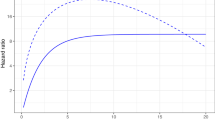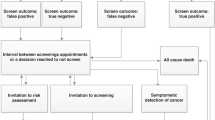Abstract
Randomized trials have demonstrated that mammographic screening can reduce breast cancer mortality. Our aim was to estimate the reduction in mortality expected from the East Anglian breast screening programme. Breast screening achieves benefit by improving cancer prognosis (reducing tumour size, nodal involvement and possibly grade) through earlier diagnosis. We compared cancer prognosis between women invited for screening and those not yet invited in East Anglia, UK, in order to predict the mortality reduction achievable by screening, independently of any reduction due to changes in treatment and underlying disease. Participants (both invited and not-yet invited) were women eligible for invitation to first and second screens and diagnosed with invasive breast cancer in 1989–96. Death rates were predicted based on the observed distribution of tumour grade, size and node status amongst 950 cancers diagnosed following first invitation, up to and including at second screen (excluding those detected at first screening), and 451 cancers presenting symptomatically in women awaiting first invitation during the staggered introduction of screening, after adjustment for lead time amongst screen detected cases. For all ages, the ratio of predicted breast cancer mortality in the invited compared with the uninvited group was 0.85 (95% CI 0.78, 0.93). It was 0.93 (0.80, 1.08) for women aged 50–54 at diagnosis and 0.81 (0.72, 0.91) for those aged 55–64. We conclude that, by 2004, the second round of screening in East Anglia should reduce mortality by around 7% in women below age 55 at diagnosis, and by around 19% in those aged 55–64. © 2001 Cancer Research Campaign http://www.bjcancer.com
Similar content being viewed by others
Article PDF
Change history
16 November 2011
This paper was modified 12 months after initial publication to switch to Creative Commons licence terms, as noted at publication
References
Beral V, Herman C, Reeves G and Peto R (1995) Sudden fall in breast cancer death rates in England and Wales. Lancet 345: 1642–1643
Blanks RG, Moss SM, McGahan C, Quinn M and Babb PJ (2000) Effect of NHS breast screening programme on mortality from breast cancer in England and Wales 1990–98: Comparison of observed with predicted mortality. Br Med J 321: 665–669
Chen HH, Duffy S, Tabar L and Day NE (1997) Markov chain models for the progression of breast cancer, part 1: tumour attributes and the preclinical screen-detectable phase. J Epidemiol Biostat 2: 9–23
Coleman MP, Babbs P, Damiecki P, Grosclaude P, Honjo S, Jones J, Knerer G, Pitard A, Quinn M, Sloggett A and De Stavola B (1999). Cancer survival trends in England and Wales 1971–1995: deprivation and NHS region. Office for National Statistics: London
Cox DR (1972) Regression model and life tables. J R Stat Soc B 34: 187–220
Day NE and Duffy S (1996) Trial design based on surrogate endpoints: application to a trial of different breast screening frequencies. J R Stat Soc A 159: 49–60
Day NE, McCann J, Camilleri-Ferrante C, Britton P, Hurst G, Cush S and Duffy S (1995) Monitoring interval cancers in breast screening programmes: the East Anglian experience. J Med Screening 2: 180–185
Duffy S, Chen HH, Tabar L, Fagerberg G and Paci E (1996) Sojourn time, sensitivity and positive predictive value of mammography screening for breast cancer in women aged 40–49. Int J Epidemiol 25: 1139–1145
Gøtzsche PC and Olsen O (2000) Is screening for breast cancer with mammography justifiable?. Lancet 355: 129–134
Henderson BE, Pike MC, Bernstein L and Ross RK (1996) Breast cancer. In: Cancer epidemiology and prevention. Schottenfeld D Fraumeni Jr JF (eds), Oxford University Press: New York, Oxford
McCann J, Stockton D and Day NE (1998) Breast cancer in East Anglia: the impact of the breast screening programme on stage at diagnosis. J Med Screening 5: 42–48
Morrison AS (1992) Early detection: sensitivity and lead time. In: Screening in Chronic Disease, pp 43–73. Oxford University Press: New York, Oxford
Organising committee collaborators and FM (1996) Breast cancer screening with mammography in women aged 40–49 years. Int J Cancer 68: 693–699
Peto R, Boreham J, Clarke M, Davies C and Beral V (2000) UK and USA breast cancer deaths down 25% in year 2000 at ages 20–69 years. Lancet 355: 1822–1830
Secretary of State for Health (1992) The Health of the Nation. A strategy for health in England. London, HMSO.
Sjönell G and Ståhle L (1999) Mammography screening does not significantly reduce breast cancer mortality in Swedish daily practice. Lakartidningen 96: 904–913
Stockton D, Davies T, Day NE and McCann J (1997) Retrospective study of reasons for improved survival in patients with breast cancer in East Anglia: earlier diagnosis or better treatment?. BMJ 314: 472–475
Tabar L, Gad A, Holmberg LH, Ljungquist U, Eklund G, Fagerberg CJG, Baldetorp L, Gröntoft O, Lundström B, Månson JC and Day NE (1985) Reduction in breast cancer mortality by mass screening with mammography: first results of a randomised trial in two Swedish counties. Lancet 1: 829–832
Tabar L, Fagerberg CJG, Day NE and Holmberg L (1987) What is the optimum interval between mammographic screening examinations? An analysis based on the latest results of the Swedish two county breast cancer screening trial. Br J Cancer 55: 547–551
Tabar L, Fagerberg CJG, Duffy S, Day NE, Gad A and Grontoft O (1992) Update of the Swedish two-county program of mammographic screening for breast cancer. Radiol Clin North Am 30: 187–209
Tabar L, Fagerberg G, Chen HH, Duffy S, Smart C, Gad A and Smith RA (1995) Efficacy of breast cancer screening by age. Cancer 75: 2507–2517
Tabar L, Duffy S, Chen HH, Vitak B and Prevost T (1999) The natural history of breast carcinoma. What have we learned from screening?. Cancer 86: 449–462
Woodman CBJ, Threlfall AG and Boggis CRM (1995) Is the three year breast screening interval too long? Occurrence of interval cancers in the NHS breast screening programme’s north western region. BMJ 310: 224–226
World Health Organisation (1990). International Statistical Classification of Diseases and Related Health Problems. World Health Organisation: Geneva
Young KC, Wallis MG, Blanks RG and Moss SM (1997) Influence of number of views and mammographic film density on the detection of invasive cancers: results from the NHS breast screening programme. British Journal of Radiology 70: 487–488
Author information
Authors and Affiliations
Rights and permissions
From twelve months after its original publication, this work is licensed under the Creative Commons Attribution-NonCommercial-Share Alike 3.0 Unported License. To view a copy of this license, visit http://creativecommons.org/licenses/by-nc-sa/3.0/
About this article
Cite this article
McCann, J., Duffy, S. & Day, N. Predicted long-term mortality reduction associated with the second round of breast screening in East Anglia. Br J Cancer 84, 423–428 (2001). https://doi.org/10.1054/bjoc.2000.1609
Received:
Revised:
Accepted:
Published:
Issue date:
DOI: https://doi.org/10.1054/bjoc.2000.1609
Keywords
This article is cited by
-
Reduction in rate of node metastases with breast screening: consistency of association with tumor size
Breast Cancer Research and Treatment (2013)
-
The NHS breast cancer screening programme
British Journal of Cancer (2003)
-
Impact of false-positive mammography on subsequent screening attendance and risk of cancer
Breast Cancer Research (2002)



